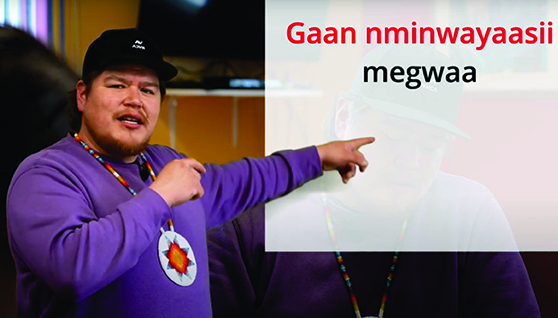Nipissing First Nation teaches Anishinaabemowin on YouTube

By Kirk Titmuss
NIPISSING FIRST NATION – It’s been a labour of love and a love of Anishinaabemowin (the Anishinaabe language) for Nipissing First Nation’s Culture and Language Department staff who have been teaching it through self-created YouTube videos.
Nishnaabemwin E-Kinoomaaged (Anishinaabemowin teacher) Blair Beaucage and Inaadziwin minwa Nishnaabemwin (Culture and Language Coordinator) Katelynn Goulais create entertaining, instructional videos and make them available on their YouTube channel, Nipissing First Nation Administration. Nipissing First Nation’s Nishnaabemwin Eniigaanzid (Culture and Language Manager), Mindy Lariviere, credits her two enthusiastic staffers for getting the engaging program off the ground last year.
The videos feature Beaucage teaching simple Anishinaabemowin words and phrases using humour and repetition.
The “Nishnaabemwin Simple Conversation” video is of Beaucage and a friend having a very short, laugh-filled chat about how the two are feeling. After the discussion ends, Beaucage breaks down the words and phrases used, displaying them on screen and pronouncing them repeatedly.
Co-creator Katelynn Goulais feels Beaucage’s delivery is what makes the videos so appealing to viewers.
“He’s been a teacher for a long time, so he has all the knowledge and he has all the tools to take information from his own head and the language and put it into people’s heads really effectively.”
Lariviere says the combination of Beaucage’s on-camera teaching technique with Goulais’ creative video production result in entertaining videos that make learning what Lariviere says, is a difficult language a much easier process.
“I feel that a lot of new learners are picking it up and realizing and seeing how easy it is to sit through maybe a five, 10-minute video and kind of go, ‘Ah, I understand it.’”
Anishinaabemowin has been on a steep decline in Nipissing, says Lariviere, due mostly to the dwindling number of Elders who are fluent in the traditional language. She says the trend worries her.
“I do know that we are losing our speakers at a dramatic pace, and I think that it’s time for our language to be called in a state of emergency.”
Statistics back Lariviere’s concern. In the last 20 years, 60 per cent of Anishinaabemowin speakers have passed away. The Anishinabek Nation Socio-Demographic Profile – a survey conducted in 2018 by Prologica Research Inc. and based on the 2016 Census of Canada, indicates 96 per cent of Anishinaabe people do not speak Anishinaabemowin at home and only 12 per cent say it’s their first language.
Beaucage has been teaching the language through various organizations in North Bay for the past 10 years. He says his lessons usually took place on Wednesdays, with reminders to his students to use Anishinaabemowin on that day. But he felt the once-a-week lessons didn’t allow the language to sink in. That’s why he and co-worker Katelynn came up with trying social media – notably YouTube – which allows learners to watch the lessons over and over whenever they want.
Goulais says what started out as an experiment has become a popular and effective teaching tool.
“I just thought it was really good for people to watch a video because I go on YouTube to learn most of the things I know. So, I just was like, what if we get a YouTube video for people to watch and then continuously hear it, and they can go back in the lesson, listen again, and then attempt to speak?”.
Lariviere says the videos are proving to be a hit with the community’s youth, especially in light of that demographic’s push to learn about their Anishinaabe ancestry and traditions.
“I have spoken to some young people and their hunger for our language and culture is definitely increasing.”
She says the community’s adoption of the Anishinabek Nation Governance Agreement Act, a historical agreement between Canada and the Anishinabek Nation recognizing the Signatory First Nations’ right to chart their own course under four pillars of governance: leadership selection, language and culture, citizenship, and management and operations, has made the video program’s growth possible.
“The Governance Agreement allowed for our program (Culture and Language) to have more funding so that we can take these ideas and put them into real-time for our community and other communities, too. And hopefully they come and follow suit as well to what we’re doing for our Nation here at Nipissing, but also other Nations that are part of this Agreement.”
The Agreement provides each Signatory First Nation enhanced funding that supports their work implementing the four pillars of governance.
Lariviere says her department is looking at other options for the videos down the road.
“When you hear about language learning and you go to a class and people are talking, you don’t understand what they are saying, and it could be very overwhelming, so having Blair’s expertise break down that language, the feedback has mostly been on the digital content of it of how pretty it looks and the breakdown of the language that Blair brings to the table.”
Beaucage encourages others who are inspired by Nipissing First Nation’s Anishinaabemowin videos to create their own or come up with other ways of spreading the language.
“Anyone, go ahead and just make, and I’m hoping people do take the stuff and either mimic it, either make shirts, make anything because we need to plaster this place with language because we need to remind ourselves.”


